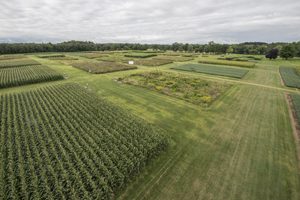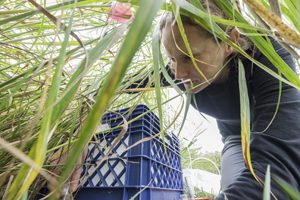The tier-one research at MSU’s Kellogg Biological Station includes projects spanning from prairie restoration to the evolution of phytoplankton resulting from climate change. Undergraduates from universities all over the country are attracted to the projects here, which is why they chose to spend Summer 2016 doing research under the guidance of the renowned scientists at KBS. On Wednesday, May 25, many undergraduate researchers had the opportunity to tour a field site that is making big progress in the area of renewable energy.
The Great Lakes Bioenergy Research Center (GLBRC) has an ongoing partnership between University of Wisconsin–Madison and Michigan State University; the sites where they perform research sweep the Great Lakes area. The GLBRC is a pioneer in the field of bioenergy as scientists and students research low-input biofuel sources to meet the demand for transportation fuels. Not only are they making progress with their science, but they are also urging cooperation between the academic, private, and federal sectors that are essential to changing our energy futures.
Since the U.S. Department of Energy has recognized a need for renewable energy sources, bioenergy is a growing field for research. Corn-based ethanol has been in commercial use for several decades, but it is a problematic alternative to fossil fuel consumption. Humans require increased food yields to support the growing number of people on Earth. Producing fuel from corn, however, will only detract from the food supply. Additionally, corn-based fuel production requires nonrenewable fossil fuels for fertilization, production, transportation, and processing; this seems counterintuitive to the sustainable ideal for biofuels.
That’s why the GLBRC is trying to understand and develop new types of cellulosic (cellulose-based, rather than corn-based) ethanol. Their experiments look at variations of plant growth, from high-input monocropping to low-input prairielands. While reducing input intensity, researchers are also looking for species – particularly perennial plants native to the Great Lakes region – that maintain high levels of wildlife biodiversity.
Guided by Dr. Sarah Roley, an ecologist interested in nutrient-cycling in ecosystems, the student researchers had the opportunity to explore the fascinating site here at KBS. Plants ranging from corn stover to miscanthus to hybrid poplar trees are important at the GLBRC, as they are in Dr. Roley’s research. She is exploring the ecological relationships between plants and the nitrogen-cycle
(read more here).
Overall, the mission of the GLBRC is to have minimal resource inputs that ideally result in high energy outputs. Students who come to research at KBS care about the sustainability goals that the project values; the project retains its significance. As the collaboration between students, scientists, government, and industry continues, the field of cellulosic



A legacy of conservation; a commitment to sustainability.
3700 E. Gull Lake Drive
Hickory Corners, MI 49060
(269) 671-5117
info@kbs.msu.edu